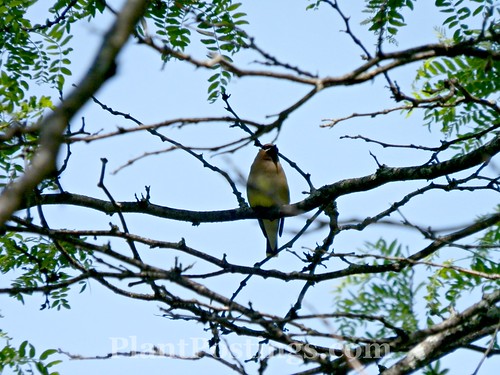 |
| The cedar waxwings are still happy and hanging around the neighborhood. |
How would you describe the perfect conditions to grow just about any plant and keep the people and creatures happy? How about: plentiful sun, occasional rain; average highs around 75F-80F/24C-27C and average lows around 55F/13C; long days and short, calm nights. Oh, and near-perfect Midwestern silt loam soil. What am I forgetting?
Anyway, you get the idea. Conditions have been near-perfect for growing things around here, and the plants seem to be growing inches every day.
It's time to talk summer gardening!
Three garden bloggers started a virtual garden club several weeks ago, under the name "Dear Friend and Gardener": Carol Michel of May Dreams Gardens, Dee Nash of Red Dirt Ramblings, and Mary Ann Newcomer of Gardens of the Wild Wild West. They invited others to join in. So I did.
The idea is to share our adventures of growing our own food, flowers, and herbs. So the focus of this post is on my one small patch of sun in this zone 5 Southern Wisconsin garden--my potager. Most definitions of potager refer to a small garden that combines both edible and ornamental plants.
That's how I've always done it. It's a great form of companion planting. The flowers attract the pollinators, which pollinate the edibles. The edibles add nutrients back to the soil, which boost the flower production. There are more intricacies, which I'll explain in a later post.
But first, let me show you the progress so far this season. Warning: These are unedited photos, straight out of the camera. The idea with this post is to show what I'm growing, and frankly, my potager isn't fancy. It's a working garden where I grow a few veggies for the family and flowers for church and home. You'll see that I still need to weed the grass out of the Drumstick Alliums, the garden is planted near the utility meter and the air conditioner (the only side of the house where I have sun!), and the window-well covers need to be replaced. The potager is surrounded by multiple layers of fencing to keep out the rabbits!
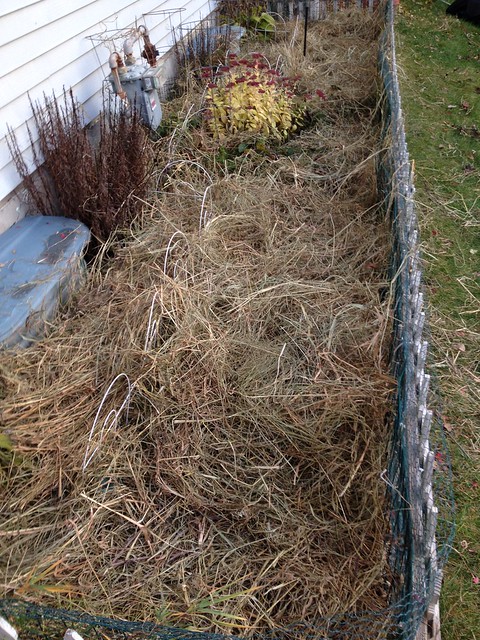 |
The potager in November 2013: Mulched in with Marsh Hay and ready for the
polar vortex?
|
To give you a true picture, I have to start back in November when I put the garden to bed for the winter. I've tried various methods, but I always go back to Marsh Hay. For me, it's the perfect mulch. It contains very few weed seeds (unlike Field Hay and Straw), it knits together and doesn't blow away in the wind, and it breaks down at a slow to moderate rate. In the meantime, it offers the perfect levels of protection and nutrients.
Also, the lasagna, or layered, method of prepping the soil yields incredible results. First, a layer of Marsh Hay, next compost, then newspaper, and finally a thick blanket of additional Marsh Hay. This cuts down on the weeds, and by the following spring the soil is soft, pliable, healthy, and ready for plants.
 |
| A different angle in November. Please don't mind the mess. |
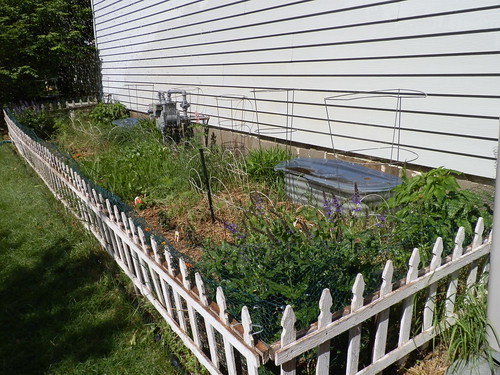 |
| The potager in early June 2014. Again, not exactly lovely, with the utility meter and the window wells, but I have to take advantage of any sun I can get. |
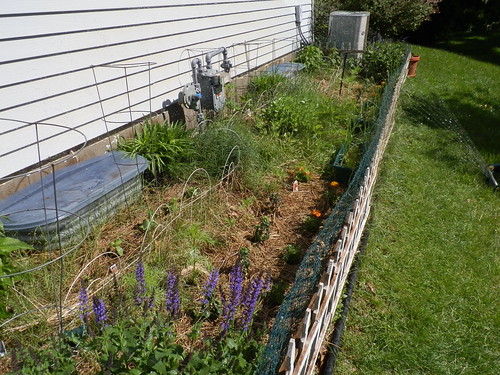 |
| A different angle. |
So, what am I growing this season? Here are the perennial, annual, biennial, and vegetable potager plants, in no particular order. I added a (C) next to ornamentals I regularly use for cut flowers.
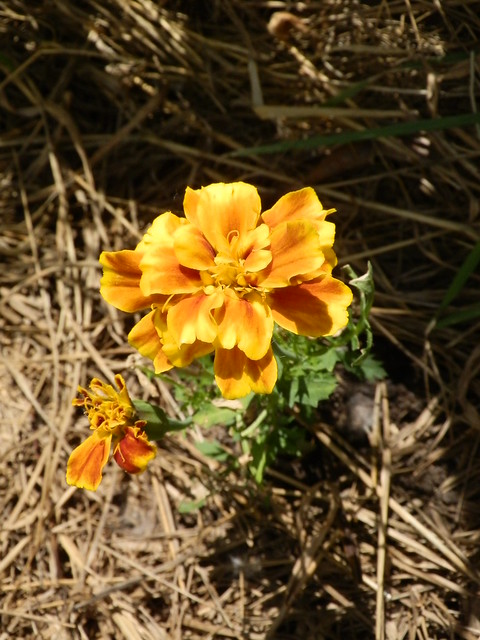 |
| Various garden Marigolds (Tagetes patula). |
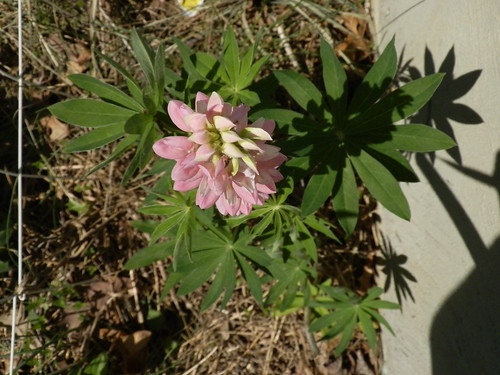 |
| Lupines (C) (Lupinus polyphyllus 'Russell'). |
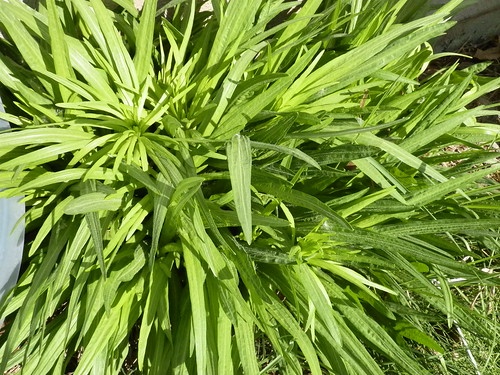 |
| Blazing Star (C) (Liatris spicata). |
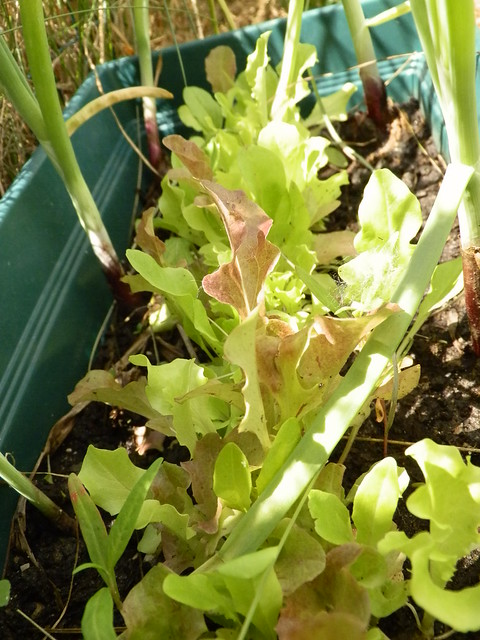 |
| Mesclun Mix Lettuce, grown from seed in raised troughs and bordered by scallions. |
 |
| Shrub Verbena (Lantana camara). The pollinators love it. |
 |
Hollyhocks (Alcea rosea 'Newport Pink Double'). Only $1.99 per plant, so I couldn't resist
adding these biennials again after they died off following the 2012 drought.
|
 |
| Coneflower (C) (Echinacea purpurea). |
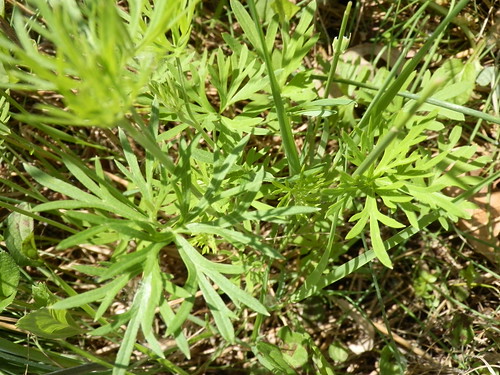 |
Delphinium spp. (C) (Looks like its twin on the other side will bounce back after the meter
guy crushed it!)
|
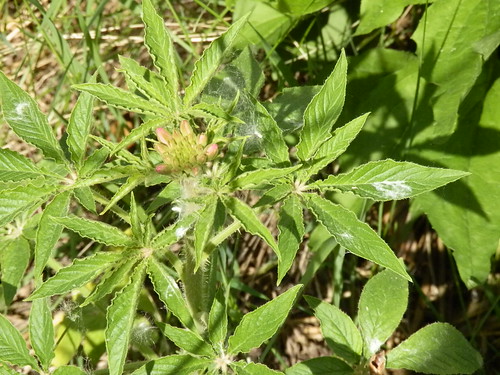 |
| Spider Flower (C) (Cleome hassleriana). The white, fuzzy stuff on the leaves is Cottonwood seeds. No worries; they'll wash off with rain. |
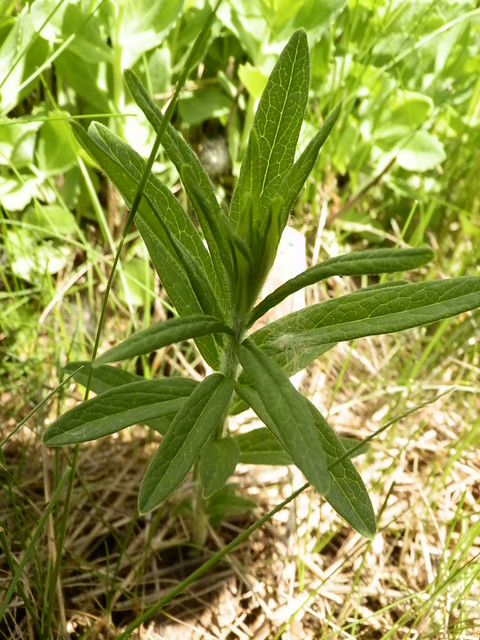 |
Butterfly Weed (Asclepias tuberosa), which has made impressive progress since my
last post.
|
 |
| Snapdragons (C) (Antirrhinum majus 'Rocket Mix'). |
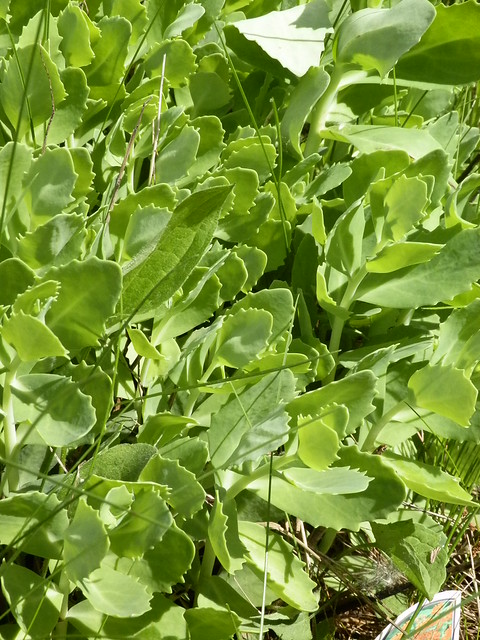 |
| Stonecrop (C) (Sedum telphinum 'Autumn Joy'). |
 |
Ornamental Sage (Salvia nemerosa). Pollinators love this one, too. Doesn't last long in a
vase, though. I guess my worries about it this winter were unfounded because it looks
better than ever.
|
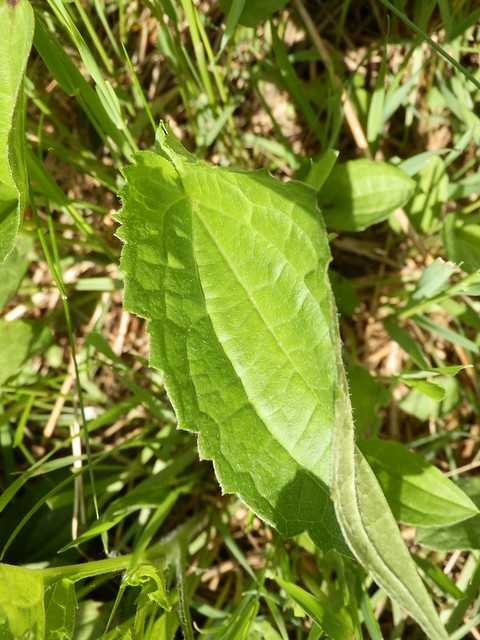 |
Black-Eyed Susan (Rudbeckia hirta). Kind of a mess right now and hard to weed around,
but that will correct itself soon.
|
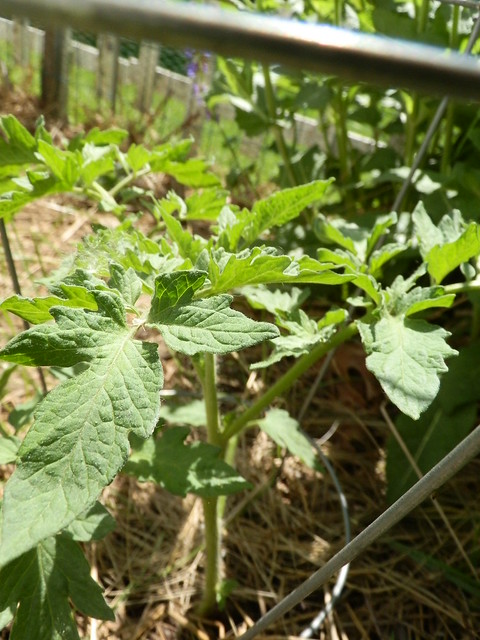 |
| 'Better Boy' Tomato. (My mouth is watering just thinking about the harvest.) |
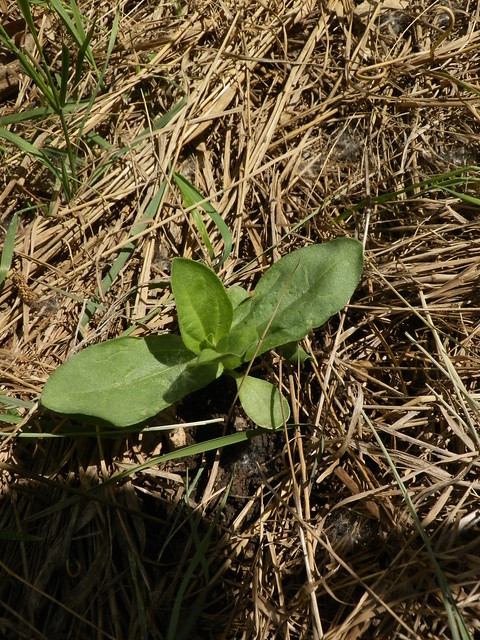 |
| Zinnias (C) (Z. elegans 'State Fair Mix'). Don't worry, they grow fast! |
Oh, and I thought I had photos of the Drumstick Alliums and the Cucumbers, but I guess I missed them. I'll share them next month ...
Head on over to the Dear Friend and Gardener page to learn more about edibles and flowers that other folks are growing!


It is fabulous Beth! I love how you prep your bed for a healthy growing season. Where do you find march hay? I grow organically and find it difficult to get an organic source of mulch for my raised beds.
ReplyDeleteThere are several farms and garden centers around here that sell Marsh Hay or give it away for free! I've tried using mulching materials (Honey Locust leaves, pine needles, etc.) that I have here, but the Marsh Hay works so well, and I don't have to go far to get it. I can't say enough good things about it! My entire garden is organic, too. In some areas (especially where I have ground cover plants), the Oak leaves serve as mulch, too, but they take a long time to decompose.
DeleteLearning something every day . . . potager
ReplyDeleteYeah, it's not a fancy potager, but I guess it meets the definition. ;-)
DeleteInspiring, I often have problem with my raised bed, caused by my kitties. The mulch and the wire mesh maybe could help me to reduce the damage. Thanks for sharing.
ReplyDeleteWe have a few roaming cats here, too (not mine--they stay inside), but I haven't had any problems with them (yet) in this particular garden plot. I did see one marking my compost bin the other day, though. Hmmmm...
DeleteI have the same problem for an organic mulch so we mow the leaves in fall and I use the leaves and grass as a mulch for the winter. I am trying to use grass as a mulch for summer as well since we do not use chemicals in the grass....I love your potager....flowers and veggies make a great combo Beth!!
ReplyDeleteThanks, Donna. I use grass, too, as I pull it from around the plants. It's a great mulch! My garden is organic, as well. I guess I forgot to mention it in this post, so I'll have to do that next time. :)
DeleteBEAUTIFUL :)
ReplyDeleteOK, I have to ask -- Is the Lantana camara really hardy for you?!
Thanks, Aaron. It's actually a little messy, but oh well. To answer your question: No, Lantana is strictly an annual here. It loves our hot summers, but dies in October with the first killing frost. Which I suppose is good because I've heard that it can be invasive in milder climates.
DeleteWonderful post and the garden looks great. I will have no photos of last fall, but I will put up my Dear Friend and Gardener post within a couple of days. We got off to such a slow start, and there is so little to show for a while after planting seeds. I am looking forward to getting some photo worthy gardening done this weekend.
ReplyDeleteThanks! It's always a mad dash at the end of May (after the last threat of frost) to get the garden in and make the most of the short growing season. Good for you to be growing from seed. I'm trying to do that with some plants, but our growing season is so short. I'll look forward to your posts!
DeleteYou have a lovely kitchen garden Beth, with a good combination of ornamental and edibles. All your preparations sounds a bit like what I had to do in Norway to get my plants to survive the winter. None of this is necessary over here in London, and my kitchen garden is on top of my nursery shelves – I grow my edibles in the 4 big containers on the top, well away from any cats and foxes and even the squirrels leave them in peace. Looking forward to seeing your next post from this area!
ReplyDeleteThanks, Helene. Lucky you, with the mild winter! All the plants in my garden either die and have to be replaced or go completely dormant during the winter ... well except for the evergreens, of course. But I don't have any of those in the potager. ;-) Good idea to put the edibles up high--away from the critters. I'm tryng that with some additional Lettuces and Scallions. They seem to be doing OK, but they don't get much sun.
DeleteThat's a very useful piece of land there Beth and good to know you make the best of it. One of my local garden centres has an entire section for the potager gardener - it's good to know the old ways are best and are becoming more popular again.
ReplyDeleteIt makes sense to plant a mix, doesn't it? Especially on a small scale, I guess, when you're doing it for fun and for your family. Wouldn't it be great if every family could have their own little gardens?
DeleteNice posting Beth. I have been combining herbs, vegetables, flowers and perennials for years. It was more because I don't have much space, but another reason was because our city has an ordinance on planting veggies in the front yard. I just had to buck the system and plant the excess tomatoes and peppers in the front garden. It bugged me that the neighbors would think this inappropriate. The veggies were well "hidden" with all the perennial growth and they were none the wiser. I really like your hay mulch. It looks so "country".
ReplyDeleteThanks, Donna. How interesting about your city ordinances. You had me chuckling about the "hidden" veggies. I don't have a lot of edibles, because it's such a small plot and I like to grow cut flowers, too. Plus, we get a CSA share every other week. But it's fun to grow some veggies. The Marsh Hay is such a good mulch and a great amendment to the soil.
DeleteA great combination of ornamentals and edibles! I also combine edibles and ornamentals. I think your potager looks very nice. In search of more sun, my own kitchen garden has expanded to the former dog lot, complete with old dog house.
ReplyDeleteThanks--it's small but productive. ;-) At our old house, I had a much larger vegetable garden and I do miss it. But we've been here 14 years, and I've learned to appreciate a shady garden, too. Our summer utility bills are quite reasonable since we don't have to use the air-conditioning as much, and when we do it doesn't kick in as much as it would if we had a sunny lot.
DeleteI like that you've turned your utility side into a veggie bed. I only grow a few vegetables but they're mixed in with my flowers. I used the same rabbit fencing to keep out my bunnies, too. So far it's working! I'm already thinking of ways to protect my plants this winter after losing so many. I may modify your lasagna method with some of my containers.
ReplyDeleteIt seems to work OK, and kind of helps beautify that side of the house as much as possible with all that hardware over there. Especially later in the summer when things fill in a bit more. I'm thinking I might go back to mainly annuals (and fall/winter sowing) in pots after my experience this past winter. It's just too cold here to grow perennials in pots and expect them to survive. I could lug them into the garage, but that doesn't seem like fun. Or maybe I could pull more into the sunroom -- but that gets messy. What's a gardener to do? ;-) But your climate is a bit warmer, so maybe the lasagna method in pots would work well for you.
DeleteGreat selection of plants. Where do you get marsh hay? You can buy baled straw around here but I never see marsh hay. I'm trying to grow more annuals for cutting this year, mostly sunflowers and tithonia.
ReplyDeleteHi Jason: I don't know if you'll check back, so I'll try to remember to leave a comment on your blog, too. If you're ever traveling through Madison and have some extra space in your vehicle, you can get bales of Marsh Hay at Klein Floral and some of the local farms. Here's a link from Becker Family Farms: Marsh Hay Info.
DeleteI think your potager is splendid. I wish we could get marsh hay here. Unfortunately, we can only get straw, and yes, it's often full of seeds. Thanks for joining in the club! We're so glad to have you posting too. I think it's awesome to see what others are growing. Did you know the term potager comes from potage which means soup? So, we have soup gardens. Neat, huh?~~Dee
ReplyDeleteThanks, Dee. I agree it's great fun to see what other gardeners are growing--in addition to perennials and annuals, also their food crops and ornamentals for cut flowers. Soup gardens--yay! Now I'm hungry. ;-)
DeleteI've always envied people who can always go home everyday after work, that means they personally care and maintain their gardens. It also seems easier to garden in climates when you can finish the work without sweating so much. And last it is easier if there is enough fund for everything you need, and the things you need are available nearby. Oh i love to have all of these, cause i have all the enumerated opposites!
ReplyDeleteIt is a blessing to be able to garden each day at home. But I had to chuckle about not sweating. Of course our climate isn't as hot as yours, but I definitely sweat when I garden. ;-) Especially on the hot, humid Midwestern days when the temperature exceeds about 85F/29C. That seems to be my transition zone. If the temps are above 95F/35C, I prefer a cool lemonade in the shade. ;) Regarding funds, well, I wish I had more, too.
DeleteSo this is where the meter reader trampled! You would think he would have known better; glad most everything is coming back. I usually plant marigolds and nasturtiums in my veggie garden, but have never thought to plant so many different flowers--I love the effect you have created. Like Dee, I wish we could get marsh hay here. I use straw which helps, but this fall I may take your suggestion and cover the whole area more thoroughly--I'm always hoeing out weeds here!
ReplyDeleteYep, this is where it happened. Not a huge surprise, and I always think of this garden as a bit vulnerable but I would have liked some warning that they were servicing the meter. Oh well. If you have any farms with marshes or low-lying areas near you (or maybe on your property?), perhaps you can get some Marsh Hay that way. It's good stuff.
DeleteYou manage to have quite a variety in what looks like not a big space. I can't wait to see how everything progresses.
ReplyDeleteI switch things around a bit every year, but this is really the only productive sunny space in my garden. Plenty of dappled shade/sun, and of course deep shade, but this is the only really sunny spot. So, it's fun to see what it will yield each year.
DeleteI keep hearing about the lasagna method- glad to hear it really works. I know about limited sunshine, you gotta use it where you have it. Interesting that you are using the space for cut flowers, it is not something I really do. I just go visit my flowers when they are blooming.
ReplyDeleteYes, it works well, Patty. I've tried several other mulches during the past two years and neglected to put down the newspaper, with less desirable results. Last year, I used Honey Locust leaves and straw as mulch--big mistake! I don't think the Honey Locusts added desirable nutrients, and the straw added tons of grass and other weed seeds to my garden. No fun.
DeleteWhat a lovely potager, and lovely blog. Really enjoying your posts and pics!
ReplyDelete